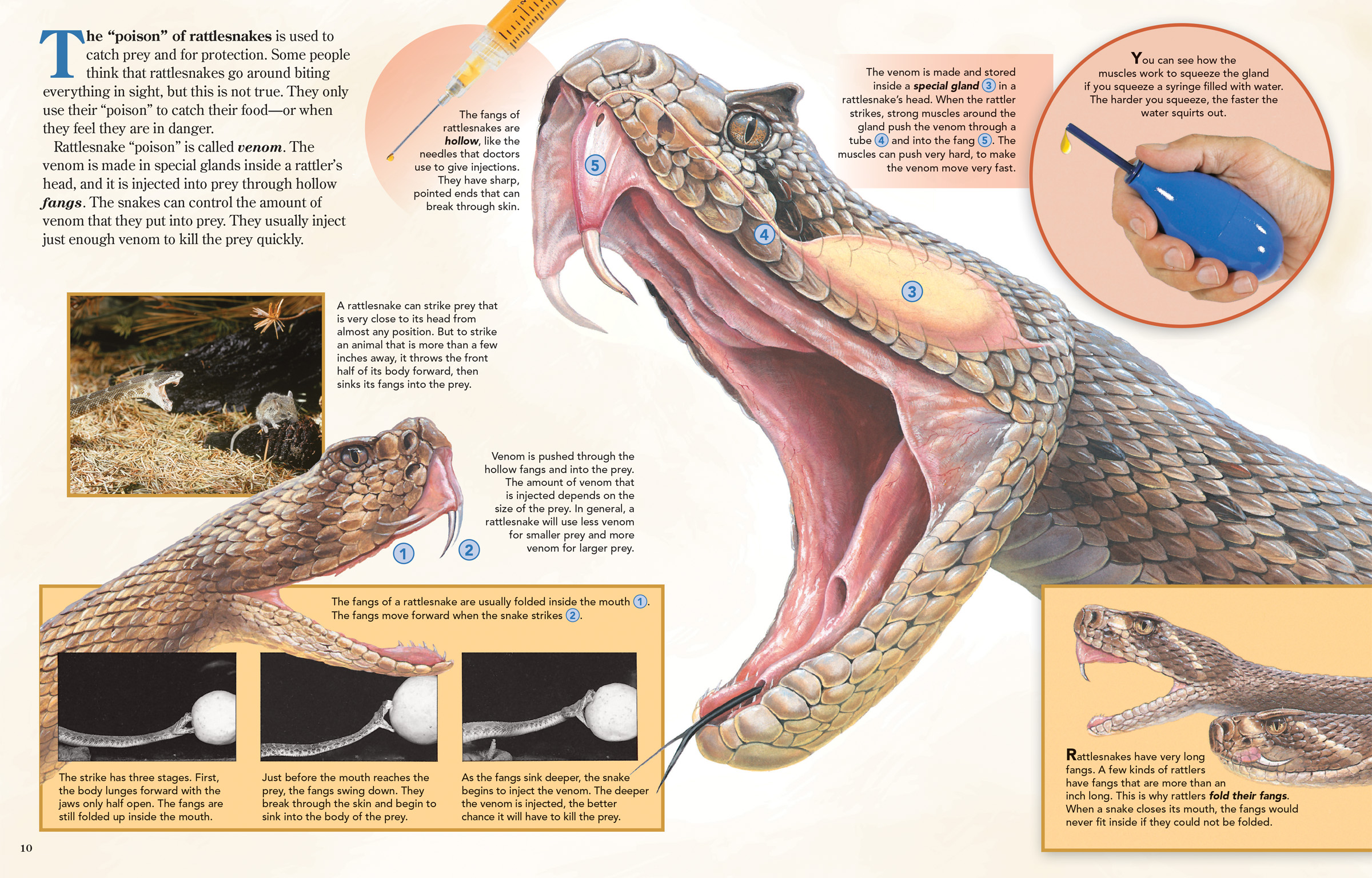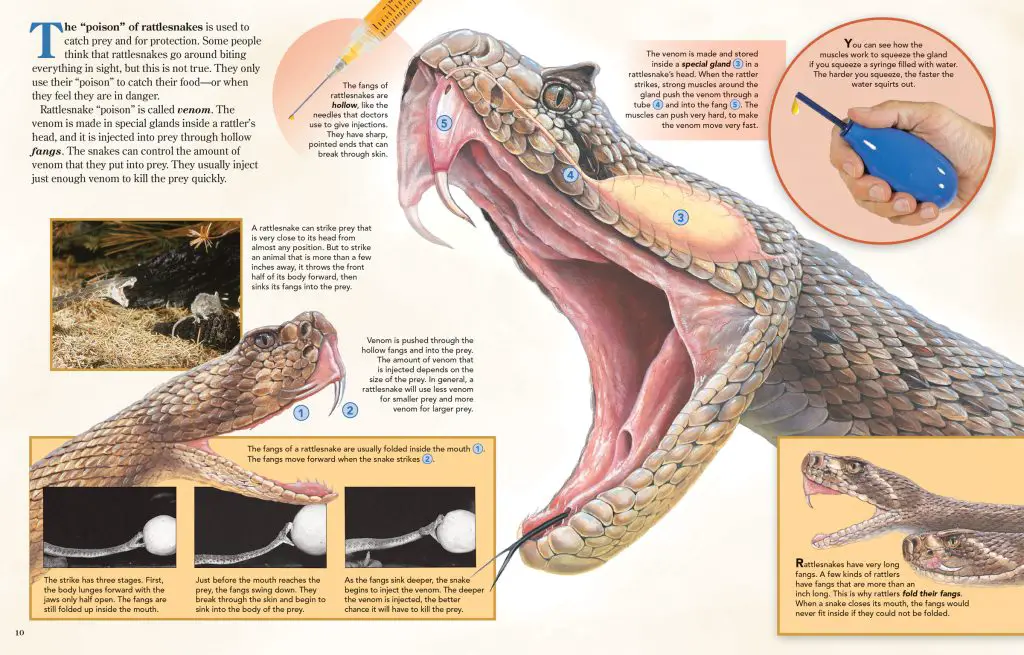Rattlesnakes are one of the most iconic and feared snakes in the world. Their distinctive rattle and venomous bite make them a force to be reckoned with in the animal kingdom. But have you ever wondered what kind of venom is produced by these slithering serpents?
Rattlesnakes are known to produce a potent cocktail of venom that can cause a range of symptoms in their prey or unfortunate human victims. From paralysis to organ failure, the effects of a rattlesnake bite can be deadly. In this article, we’ll dive deeper into the types of venom produced by rattlesnakes and how they affect their prey.
Rattlesnakes have a venom that is a mixture of enzymes and toxins. The venom attacks the victim’s nervous system, leading to paralysis and death in severe cases. The venom also contains proteins that break down tissues and blood cells, causing swelling and pain. Different species of rattlesnakes have different types of venom that vary in potency and composition.

What Kind of Venom Does a Rattlesnake Have?
Rattlesnakes are a group of venomous snakes found in North and South America. They are known for their distinctive rattle, which they use as a warning to potential predators. But what kind of venom do rattlesnakes have? Let’s explore the different types of venom produced by these snakes and their effects on humans.
Types of Venom Produced by Rattlesnakes
Rattlesnakes produce two types of venom: hemotoxic and neurotoxic. Hemotoxic venom affects the blood and tissues, while neurotoxic venom affects the nervous system. Some species of rattlesnakes produce more hemotoxic venom, while others produce more neurotoxic venom.
Hemotoxic Venom
Hemotoxic venom contains enzymes that break down the tissues and cells of the victim. This can lead to severe pain, swelling, and tissue damage. In extreme cases, the venom can cause the victim’s blood to not clot properly, leading to internal bleeding and death. Hemotoxic venom is produced by the majority of rattlesnake species, including the western diamondback rattlesnake and the timber rattlesnake.
Neurotoxic Venom
Neurotoxic venom affects the nervous system of the victim. It can cause paralysis, respiratory failure, and death. Neurotoxic venom is produced by some species of rattlesnakes, including the Mojave rattlesnake and the eastern coral snake.
Effects of Rattlesnake Venom on Humans
The effects of rattlesnake venom on humans can vary depending on the species of snake and the amount of venom injected. In general, the symptoms of a rattlesnake bite include:
Pain and Swelling
The area around the bite will likely become painful and swollen. The pain can be severe and may spread to other parts of the body.
Bruising and Discoloration
The skin around the bite may turn blue or black and become bruised.
Nausea and Vomiting
Some victims may experience nausea and vomiting after being bitten by a rattlesnake.
Difficulty Breathing
In severe cases, rattlesnake venom can cause respiratory failure, making it difficult for the victim to breathe.
Paralysis
If the venom is neurotoxic, it can cause paralysis and potentially lead to death.
Treatment for Rattlesnake Bites
If you are bitten by a rattlesnake, it is important to seek medical attention immediately. There is no specific antidote for rattlesnake venom, but there are treatments that can help manage the symptoms and prevent complications. These may include:
Antivenom
Antivenom is a medication that can neutralize the venom in the victim’s body. It is usually administered intravenously in a hospital setting.
Pain Management
Pain medication may be given to help manage the discomfort caused by the bite.
Supportive Care
In some cases, the victim may require supportive care, such as oxygen therapy or mechanical ventilation.
Rattlesnake Venom vs. Other Types of Venom
Rattlesnake venom is just one of many types of venom produced by animals. Some other types of venom and their effects include:
Bee Venom
Bee venom can cause pain, swelling, and in severe cases, anaphylactic shock.
Spider Venom
Spider venom can cause a range of symptoms, including pain, muscle cramps, and paralysis.
Scorpion Venom
Scorpion venom can cause pain, swelling, and in severe cases, convulsions and respiratory failure.
Compared to other types of venom, rattlesnake venom is relatively potent and can cause serious harm to humans. It is important to take precautions when in areas where rattlesnakes are known to live, such as wearing protective clothing and being cautious when walking through brush or tall grass.
Conclusion
In conclusion, rattlesnakes produce two types of venom: hemotoxic and neurotoxic. Hemotoxic venom affects the blood and tissues, while neurotoxic venom affects the nervous system. The effects of rattlesnake venom on humans can vary depending on the species of snake and the amount of venom injected. If you are bitten by a rattlesnake, it is important to seek medical attention immediately. Rattlesnake venom is relatively potent compared to other types of venom, and precautions should be taken to avoid being bitten.
Frequently Asked Questions
Here are some frequently asked questions about the venom of rattlesnakes:
What are the types of venom produced by rattlesnakes?
Rattlesnakes produce two types of venom: hemotoxic and neurotoxic. Hemotoxic venom damages the tissues and blood vessels of the prey, causing swelling, pain, and internal bleeding. Neurotoxic venom, on the other hand, affects the nervous system of the prey, causing paralysis and breathing difficulties.
Most rattlesnakes produce hemotoxic venom, which is used to immobilize and kill small animals like rodents and birds. However, some species, such as the Mojave rattlesnake, produce both hemotoxic and neurotoxic venom, which can be more lethal to their prey.
What are the effects of rattlesnake venom on humans?
Rattlesnake venom can cause a range of symptoms in humans, depending on the type and amount of venom injected. Hemotoxic venom can cause severe pain, swelling, and tissue damage at the site of the bite, and can also lead to systemic effects such as nausea, vomiting, low blood pressure, and shock. Neurotoxic venom can cause symptoms such as blurred vision, difficulty speaking, muscle weakness, and difficulty breathing.
Without prompt medical treatment, rattlesnake bites can be fatal. However, most bites can be successfully treated with antivenom and supportive care, such as pain management and hydration.
How does rattlesnake venom work?
Rattlesnake venom works by breaking down the tissues and cells of the prey, making it easier for the snake to digest. The venom contains enzymes and toxins that target specific organs and systems in the prey’s body, such as the nervous system, muscles, and blood vessels.
When a rattlesnake bites a human, the venom can have similar effects, causing damage and dysfunction in the body’s tissues and systems. However, the human body has its own defense mechanisms, such as the immune system and blood clotting factors, which can help to mitigate the effects of the venom.
How is rattlesnake venom used in medicine?
Rattlesnake venom contains a variety of compounds that have potential medical applications. For example, one enzyme found in rattlesnake venom, called thrombin-like enzyme, can be used to treat blood clots and related conditions. Other compounds in rattlesnake venom have shown promise in treating cancer, pain, and neurological disorders.
However, because rattlesnake venom can be dangerous and unpredictable, these compounds must be extracted and purified using specialized techniques, and their effects on humans must be carefully studied and monitored.
How can you prevent a rattlesnake bite?
The best way to prevent a rattlesnake bite is to avoid contact with the snakes. Rattlesnakes are typically found in dry, rocky areas, and tend to be most active during the warmer months of the year. If you are hiking or working in areas where rattlesnakes may be present, wear sturdy boots and long pants, and watch where you step.
Additionally, be aware of the warning signs of a rattlesnake, such as the sound of its rattle, its distinctive triangular head, and its camouflaged coloring. If you do encounter a rattlesnake, back away slowly and give it plenty of space to move away on its own.
Deadliest Job in America – Snake Milker!
In conclusion, understanding the venom of rattlesnakes is crucial for anyone who spends time in rattlesnake territory. Being aware of the signs of a rattlesnake bite and knowing how to respond can be the difference between life and death. Remember, rattlesnakes are not naturally aggressive and will only strike when threatened. If you encounter a rattlesnake, give it plenty of space and do not attempt to handle it. Instead, appreciate these fascinating creatures from a safe distance.
In addition, it’s important to note that not all rattlesnake venom is created equal. Different species produce varying types of venom with different effects. Some rattlesnake venom causes tissue damage and necrosis, while others attack the nervous system and can lead to paralysis. Knowing which species of rattlesnake you are dealing with can help medical professionals provide the best treatment in the event of a bite.
Overall, while the venom of rattlesnakes may be intimidating, these snakes play an important role in their ecosystems. By educating ourselves about their venom and behavior, we can coexist with them safely and appreciate their unique place in the natural world.


